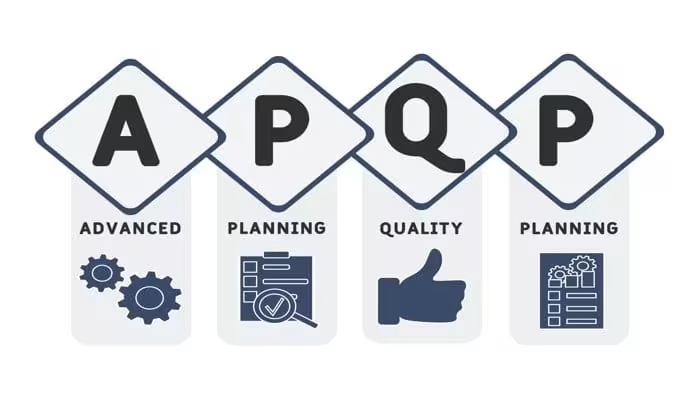Summary: Advanced Product Quality Planning (APQP) provides a structured and proactive approach to ensure high-quality products. By following the five phases of APQP: Plan and Define, Product Design and Development, Process Design and Development, Product and Process Validation, Launch, Feedback Assessment, and Corrective Action, organizations can enhance product quality, reduce risks, and improve customer satisfaction. With the integration of the Control Plan in the 3rd edition of APQP, organizations have a comprehensive tool to manage critical characteristics and ensure quality throughout the development and manufacturing processes.
Understanding APQP (Advanced Product Quality Planning)
Advanced Product Quality Planning (APQP) is a structured approach to product development that aims to ensure the quality of both the product and the process. The APQP framework supports organizations in planning, developing, and manufacturing products that meet or exceed customer expectations. APQP involves cross-functional collaboration, proactive risk assessment, and continuous improvement throughout the product development lifecycle, ensuring that the final product aligns with customer requirements and quality standards.
History of APQP
The roots of APQP lie in the 1980s when automotive manufacturers and suppliers, through the Automotive Industry Action Group (AIAG), sought to standardize product quality processes. The need for a more structured approach to ensure product quality led to the creation of APQP, initially focused on the automotive industry. Over time, the framework was adopted by various industries, becoming a key tool in enhancing product quality and reducing risks throughout the product development lifecycle.
The Product Quality Plan and APQP Process
At the core of APQP is the Product Quality Plan. This plan serves as a roadmap for the entire product development process, outlining the steps and activities necessary to achieve the desired quality outcomes. The Product Quality Plan defines the objectives, requirements, and critical checkpoints that must be met at each phase. The APQP process focuses on ensuring that these objectives are consistently met, driving product quality and reliability, as well as process stability.
Is your APQP process optimized for structured planning and consistent quality?
Support your APQP process with an EQMS
The 5 Phases of APQP
The APQP phases are integral to ensuring quality throughout the product development process. APQP consists of five distinct phases, each focusing on specific aspects of product development. This structured methodology provides a systematic approach to ensure quality at every stage of the product development process. Let’s explore these phases in detail:
Phase 1: Plan and Define
The first phase of APQP is the Plan and Define phase, which sets the foundation for achieving quality goals in new product development. In this phase, the organization establishes the project scope, defines customer requirements, and identifies the key deliverables. The goals of this phase include setting quality objectives, determining the necessary resources, and creating a project timeline. Additionally, process and product assumptions are established to guide development. This phase plays a crucial role in aligning the planning processes to ensure a structured approach for the successful completion of the project.
Phase 2: Product Design and Development
Once the project scope is defined, the organization moves into the Product Design and Development phase. Here, the focus is on designing the product based on customer requirements, translating them into specific design parameters, and creating detailed engineering specifications. This phase involves frequent collaboration between cross-functional teams and aims to ensure that the product meets customer expectations and regulatory standards.
Phase 3: Process Design and Development
In the Product and Process Design phase, the organization shifts its focus to developing the manufacturing process for the product. This phase involves identifying the critical process parameters, designing process flow diagrams, and conducting Process Failure Mode and Effects Analysis (PFMEA) to assess and mitigate potential risks. The goal is to establish a robust and efficient manufacturing process that can consistently produce high-quality products, especially in industries such as the automotive industry, where precision and quality control are paramount.
Phase 4: Product and Process Validation
The Product and Process Validation phase is crucial for verifying that the product and manufacturing process meet the defined requirements. This phase includes conducting various tests, such as product Performance Testing, Statistical Process Control (SPC), measurement system analysis (MSA) to ensure the accuracy and reliability of measurement systems, and process capability studies. The results obtained during this phase help identify any deviations from the desired quality standards and ensure that products meet customer requirements, enabling organizations to make necessary adjustments.
Phase 5: Launch, Feedback Assessment, and Corrective Action
The final phase of APQP is the Launch, Feedback Assessment, and Corrective Action phase. In this phase, the product is launched into the market, and feedback from customers and other stakeholders is collected. This feedback is then assessed to identify areas for improvement and initiate corrective actions. Continuous improvement is a key focus during this phase as organizations strive to enhance product quality and customer satisfaction.
APQP Phases at a Glance: Objectives and Tools by Stage
| Phase | Title | Objective | Key Activities / Tools |
|---|---|---|---|
| Phase 1 | Plan and Define | Define project goals, customer requirements, and resources |
• Analyze customer requirements • Form project team • Create project timeline |
| Phase 2 | Product Design and Development | Develop the product according to customer requirements |
• Design FMEA (DFMEA) • CAD modeling and engineering drawings • Design reviews • Material and tolerance specifications |
| Phase 3 | Process Design and Development | Develop a robust and efficient manufacturing process |
• Process FMEA (PFMEA) • Process flow diagrams • Tooling and equipment specifications • Production layout |
| Phase 4 | Product and Process Validation | Ensure the product and process meet defined requirements |
• Initial Sample Submission (e.g., PPAP) • Measurement System Analysis (MSA) • Statistical Process Control (SPC) • Process capability studies |
| Phase 5 | Launch, Feedback, Assessment & Corrective Action | Launch the product, gather feedback, and drive continuous improvement |
• Collect customer feedback • Root cause analysis & corrective actions • Capture lessons learned • Monitor quality KPIs |
The Benefits of APQP
Implementing APQP offers numerous benefits to organizations. Some of the key advantages include:
Improved Quality Control: APQP ensures that quality is built into the product and process from the early stages of development. By proactively identifying and addressing potential issues, organizations can minimize defects, reduce rework, and enhance overall product quality.
Enhanced Communication and Collaboration: APQP encourages cross-functional collaboration and communication among teams involved in product development. This alignment fosters a shared understanding of customer requirements, promotes knowledge sharing, and enables efficient problem-solving.
Risk Reduction: APQP incorporates risk assessment techniques, such as FMEA, to identify and mitigate potential risks early in the structured process of new product development. By addressing risks proactively, organizations can prevent costly failures, improve safety, and ensure compliance with regulatory standards.
Streamlined Development Process: APQP provides a structured framework that guides organizations through the product development process. This structure helps streamline activities, reducing time-to-market and improving overall project management.
Customer Satisfaction: With APQP, organizations can better understand and meet customer expectations. By involving customers in the early stages of development, organizations can tailor their new products to specific needs, resulting in increased customer satisfaction and loyalty.
APQP 3rd Edition and Control Plan
The APQP process has evolved, and the 3rd edition of the APQP manual introduces several updates and refinements. One significant addition in this edition is the integration of the Control Plan within the APQP process. The Control Plan provides a systematic approach to identify and document the critical characteristics of a product or process, along with the associated controls required to ensure quality.
The 3rd edition of APQP also emphasizes the importance of cross-functional involvement throughout the APQP process. It underscores the need for suppliers and other stakeholders to participate in the planning and execution of APQP activities actively.
Mastering the APQP Process: A Roadmap to Quality Excellence
Advanced Product Quality Planning (APQP) is more than just a series of steps; it’s a mindset that permeates every aspect of product development. At its core, APQP embodies the philosophy of proactive quality management, emphasizing the early detection and prevention of defects rather than reactive measures after production. This holistic approach fosters a culture of continuous improvement and drives organizations toward excellence in quality and customer satisfaction.
Next Steps
APQP offers a clear framework for ensuring quality efficiently. When combined with a robust EQMS, you can enhance the quality and transparency of your processes, driving efficiency at every stage. Optimize your future APQP cycles with a smart system that takes your quality management to the next level – faster, more systematic, and with greater precision.
FAQ | APQP Process
What is the role of APQP in product development?
APQP plays a pivotal role in product development by providing a structured approach to ensure product quality. This quality management tool helps organizations plan, develop, and manufacture products that meet customer requirements and regulatory standards. APQP serves as a critical framework to ensure a successful product by addressing quality at every stage of the development process.
What is the connection between APQP and PPAP?
APQP and Production Part Approval Process (PPAP) are closely related. APQP provides the framework for developing a product, while PPAP focuses on validating the production process and ensuring that it can consistently meet the desired quality requirements. The output of APQP serves as the foundation for PPAP, ensuring that all product and process requirements are met before the production phase begins.
How does APQP benefit suppliers?
APQP allows suppliers to better understand customer expectations, collaborate with customers and other stakeholders within the supply chain, and align their processes to deliver high-quality products. It also focuses on improving supplier quality, ensuring that all aspects of the supply chain consistently meet quality standards. It enhances communication, reduces risks, and improves overall supplier performance across the entire supply chain.
How does FMEA contribute to the APQP process?
FMEA (Failure Mode and Effects Analysis) helps identify potential failure modes, evaluate their impact, and implement preventive measures in the APQP process. By proactively addressing risks, FMEA enhances product reliability, improves design robustness, and ensures that quality standards are met throughout the development process.
What is the role of quality gates in the APQP process?
In the APQP process, Quality Gates serve as decision checkpoints between its five phases. They ensure that all requirements are met before progressing, helping to identify risks early, improve quality control, and maintain compliance with standards.
How can APQP help in continuous improvement?
APQP promotes a culture of continuous improvement by collecting feedback from customers and stakeholders, assessing performance, and taking corrective actions. It provides a framework for organizations to learn from past experiences and continually enhance their product quality and development processes.
Does implementing APQP require additional resources?
Implementing APQP may require allocating additional resources, such as personnel, time, and tools. However, the long-term benefits of improved quality, reduced risks, and enhanced customer satisfaction outweigh the initial investment.
Image: Adobe Stock – Copyright: © Nadezhda Kozhedub – stock.adobe.com





